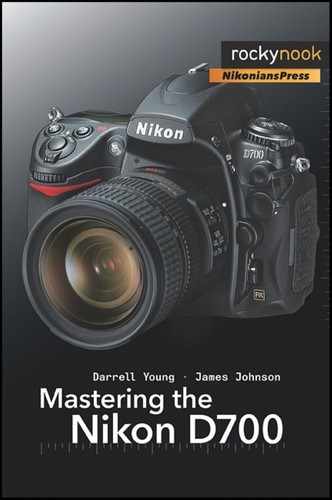Book Description
Mastering the Nikon D700 provides a wealth of information and professional insights for owners of this powerful new camera. Each chapter explores the features and capabilities of the D700 in detail, surpassing basic user manuals by providing step-by-step menu setting adjustments coupled with illustrations and logical explanations for each option. The authors' writing style allows the reader to follow directions in a friendly and informative manner, as if a friend dropped in to share his experienced knowledge without "talking down" to you, explaining the how and the why.
The learning experience for D700 beginners (and refresher information for professionals) goes beyond the camera itself. When camera features and options expand to additional Nikon equipment (such as with the use of optional Speedlights) the authors add the necessary information. Their frequent references to user manuals provided by Nikon (complete with specific page references) allow the reader to easily navigate past the confusion factor that often comes with new equipment.
Mastering the Nikon D700 is another title in the Nikonians Press series-the exciting, new, joint venture between Nikonians and Rocky Nook.
Table of Contents
- Mastering the Nikon D700
- About the Authors
- Foreword
- Preface
- 1. Using the Nikon D700
- Nikon D100 - Generation 1
- Nikon D200 – Generation 2
- Nikon D300 – Generation 3
- Nikon D700 – Generation 4
- EXPEED Image Processor
- FX vs DX Image Sensor
- 12.1-Megapixel CMOS Sensor
- Five or Eight Frames per Second
- Noise Control
- Live View
- 3-Inch Monitor
- Fine-Tuning
- Sensor Dust Cleaning
- Picture Control
- Active D-Lighting
- 51-Point Autofocus
- 12-Bit or 14-Bit Color Depth
- Lossless Compressed NEF (RAW)
- Exposure Delay Mode
- Retouch Menu
- My Menu
- 95% Viewfinder Frame
- Rubber Covers Instead of Lost Screw-On Caps
- HDMI Device Port
- My Conclusions
- 2. Exposure Metering, Exposure Modes, and Histogram
- Metering Systems
- 3D Color Matrix II Meter
- Fine-Tuning Matrix Metering
- Using Flash with Matrix Metering
- Center-Weighted Meter
- Where’s the Circle?
- What About the Averaging Meter?
- Spot Meter
- Exposure Modes
- P – Programmed Auto Mode
- Get Down, Grandpa!
- S – Shutter Priority Auto Mode
- A – Aperture Priority Auto Mode
- Understanding Depth of Field
- M – Manual Mode
- Histogram
- Understanding the Histogram
- How Does the Eye React to Light Values?
- Computer Adjustment of Images
- My Conclusions
- 3. Multi-CAM 3500FX Autofocus
- 4. White Balance
- How Does White Balance (WB) Work?
- Color Temperature
- Method 1 – Manual White Balance Using the WB Button
- Manually Selecting a Color Temperature Between 2,500 and 10,000K
- Measuring Actual Ambient Light and Using PRE (PrE)
- Storing White Balance Values for Future Use
- Saving a Current WB Reading to Memory Locations d-1 to d-4
- Using the Values Stored in Memory Locations d-0 to d-4
- Storing and Selecting the White Balance from a Previously Captured Image
- Method 2 – Manual White Balance Using the Monitor LCD’s Shooting Menu
- White Balance Bracketing
- AUTO White Balance
- White Balance Tips and Tricks
- My Conclusions
- 5. Shooting Menu Banks
- 6. Custom Setting Banks
- 7. Playback Menu
- 8. Setup Menu, Retouch Menu, and My Menu
- 9. Nikon Creative Lighting System
- What Is the Nikon Creative Lighting System (CLS)?
- How Does the D700 Fit into the CLS Scheme?
- What Is Commander Mode and How Does it Work?
- Using the Nikon D700 in Commander Mode
- Nikon SB-600 Speedlight Slave Configuration
- Using the Nikon SB-800 Speedlight as a Commander Device
- Examining the Nikon SU-800 Wireless Speedlight Commander Unit
- My Conclusions
- Nikonians Gold Membership
- Credits for Chapter Opening Images
- Index
